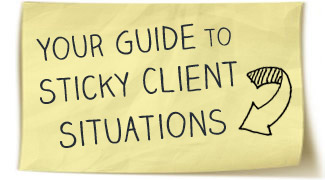
In Japan, it is unheard of to begin any sort of business discussion without some initial “chit chat.” Catching up, asking about your client’s family or recent vacation, and commenting on the weather is not nice, it’s just how things are done.
While we don’t all have the time or inclination to spend so much “work” time on personal matters, I’m a big believer myself in taking time to have conversations with business associates, in case you hadn’t noticed from the wealth of ground we cover in my video case studies!
The Pros and Cons of Client-Contractor Friendship
When you’re friendly with a client, you unfortunately open the door for things to get awkward as well.
Don’t get me wrong though. In today’s often online-only world, it’s so easy to miss these opportunities for connection, for creating relationships with fellow self-employed women as well as clients. Those relationships function as an essential sounding board, support network, and socialization when you don’t have office culture.
And engaging with your clients on a personal level benefits your business in a variety of ways:
- they think of you when new work arises
- they’re more understanding of personal issues/deadlines change requests
- you get a bigger buy-in to the client’s strategy and more control over what you work on
- the client listens when you suggest new ways to collaborate
With all these advantages on your end—largely revolving around your own working comfort and flexibility—come corresponding disadvantages:
- extra work expected as a favor
- late payments
- rush requests with no mention of extra payment
- messy break-ups involving personal frustrations or disagreements
And sometimes things go even more downhill when clients become close.
Perhaps they hit on you and immediately start giving you less and less work when you turn them down. Or, on a less extreme end, they keep asking you to chat on the phone or meet more than you have time for, and when rebuked, they stop responding to your emails as promptly and begin to treat you coldly or disagree with all your suggestions.
Once you feel things may be entering a danger zone, these three tactics can help you re-establish your relationship as strictly (but pleasantly) business.
1. Follow Up on Phone Calls with Recaps and Action Lists
On the phone, chumminess is great. That’s the time you should be connecting. But once you get off, reset the tone to show that you mean business. If you get things going in the right direction, your client should take the hint and follow up in kind.
As soon as you get off a phone call, review your notes and briefly summarize the (business-related) topics you discussed. Not only does this refocus your interaction, but it also ensures you have records of any verbal agreements, particularly regarding who is doing what or paying what when.
Include any action items (tasks), who is responsible for them and their due dates, as well as any changes to your workload. Here’s an example:

2. Awkward Email? Let it Go
When you get an email from a client that makes you uncomfortable because it is too personal, the best thing to do is not respond.
If you engage with the behavior without saying you don’t find it appropriate, you’re unfortunately opening the door for this behavior to continue in the future. With long-distance business relationships, you have so little interaction to go on that once a pattern is set, it’s incredibly difficult to break.
Typically, if you don’t respond once or twice, the client should take the hint and stick to business or ask why you aren’t responding. A simple:
“my schedule is very full and while I’m happy to work out business topics with you by email, I am not at liberty to spend my time online on personal correspondence right now”
or something similar should suffice to explain your behavior without offending your client.
If you are receiving more emails than not that are overly personal, look at your income distribution and see if it’s possible to drop the client.
If you take that step, make sure you deliver everything expected of you and receive payment for it before beginning the dissolution to avoid emotions interfering with you receiving the compensation you deserve.
3. Don’t Let Contract Changes Go Unnoticed
One of the slipperiest slopes in terms of overly friendly client relationships is when clients begin expecting that any time that ask you to do something extra, you’ll do it for free.
This practice (yes, it’s an known business issue!) is called scope creep, and we’ve got a whole post on it.
But when you are facing a sticky client relationship like this, the best thing you can do, as with email call summaries, is to be the one to set the business tone.
As soon as your client asks you for extra work, let them know you’ll need to change your contract or agreement to reflect this, send over a new draft of your terms, and don’t start on anything new until it’s signed.
If you didn’t have a contract in the first place, this is a great opportunity to set once up. Simply say:
“Since we’re adding some additional features/services/collaborations, I want to make sure that we have everything all lined up so nothing falls through the cracks.”
On the other hand, if your client keeps adding new things all the time, use that behavior as an opportunity to ask for a retainer. This is great for service-based self-employed women like writers, virtual assistants, and social media consultants.
You can say:
“You have so many great ideas on how we can collaborate, I know a better way for us to handle the billing. Why don’t we set up a retainer, and then I can do any work that comes up at $## for the month.”
Just make sure you price yourself high enough to handle everything they’ll throw at you!
Want more sticky client situations?





